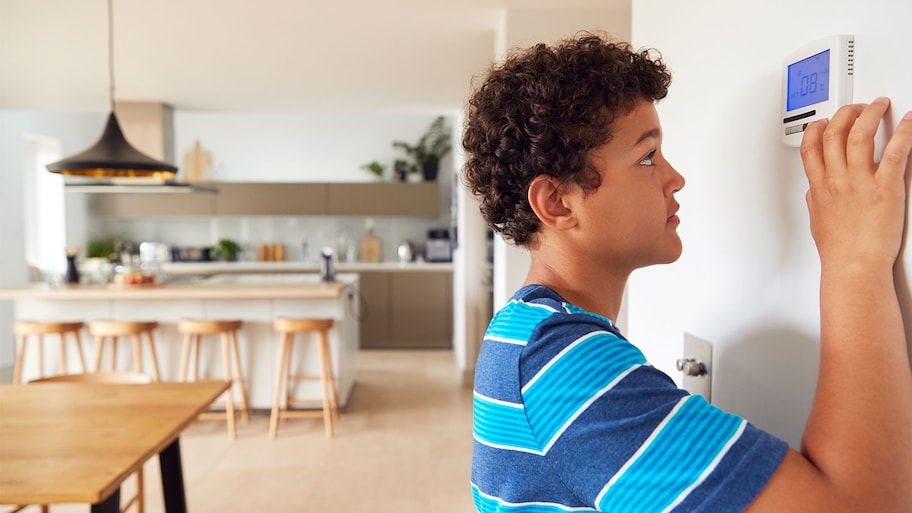Get the lowdown on HVAC systems so you won't be left in the cold (or heat)
An HVAC system is the beating heart of your home, providing clean air and comfortable temperatures when you need them most. HVAC stands for heating, ventilation, and air conditioning, so modern systems are multi-pronged entities that perform many different functions. The ventilation component filters out bacteria, moisture, and related airborne particles so you can breathe easily. In contrast, the heating and cooling components help keep your home comfy all year round.
But how do HVAC systems work? There are a wide variety of HVAC systems available to homeowners, each with its own unique design and complexities. However, most climate control systems share certain similarities. Let’s review the various parts of an HVAC system, and how they work together to keep your home running smoothly.
Heating
The heating element typically refers to a furnace, a heat pump, or a boiler that distributes heated air, steam, or fluid throughout your home. No matter where the hot air comes from, HVAC systems typically use one of the following distribution methods.
Forced Air Systems
Forced air systems are very common with newly built homes and are likely what you envision when you think of an HVAC unit. These systems force hot air through ducts using a blower. If your home features metal ductwork, you likely have a forced-air system.
Modern all-in-one HVAC systems typically feature separate sets of ductwork for heating and cooling. These systems are susceptible to many common problems, however, including blowouts. A blowout occurs when the blowers stop entirely or only work with a drastically reduced volume. Luckily, there are some DIY solutions to try before calling in a professional to fix problems with your forced-air system.
Gravity Systems
As the name suggests, gravity-based heating systems operate on the principle that cold air sinks and hot air rises. Therefore, these systems are installed in a low area of the home, typically in the basement.
When switched on, warm air rises throughout your home, heating it accordingly. When the air cools, it sinks again and it’s automatically reheated. Gravity systems are ingenious in their simplicity, but they have one major drawback. Due to the nature of their design, specifically the lack of blower motors, gravity systems don’t integrate with air conditioning units in a two-in-one capacity. In other words, you’ll need to install an air conditioner via a separate method.
Radiator Distribution Systems
Many older homes create heat through a radiator distribution system that uses a boiler. The boiler sends hot water or steam through pipes located throughout the home, which work separately from the ventilation or air conditioning systems. Radiators are a time-tested technology that have been a heating mainstay for more than a century. They allow for zoned heating and cooling, but these systems are expensive to install, at around $5,000 for the boiler and $250 to $500 for each radiator.
Ventilation
The ventilation component of an HVAC system not only assists in drawing in outside air for cooling, but it also forces hot air out of the home and filters out impurities. Modern ventilation systems vary according to design but they tend to include several universal aspects.
Air Return Vents
Air return vents mark the starting point of the ventilation cycle. The fan sucks in air through the air return vent, draws it through a filter, and then passes it into the main system to either heat or cool it, depending on the design of your system. Dirt and debris build up on these vents with continuous use, so be sure to dust them regularly.
Filters

HVAC systems typically include many dedicated air filters to weed out impurities, such as dust, bacteria, odor-causing particles, dander, and more. These filters are generally located near exit ducts throughout the home. Be sure to check these air filters regularly for a buildup of dirt and debris, and be sure to clean or replace them according to the manufacturer’s instructions. Energy Star recommends checking them once a month and replacing them every three months.
Exhaust Outlets and Ducts
Exhaust outlets release the excess heat that’s created by your heating system. These outlets are typically located on your home’s exterior, such as a chimney flue or a vent stack. Ducts, on the other hand, are the “veins” of your HVAC system. Any air transported from your heating or cooling system to the rest of your home, or to an exhaust outlet, typically travels via ductwork. You should hire a professional to clean your ductwork every two to three years, as well as check for exhaust outlet buildup once every year.
Air Conditioning
The final piece of the HVAC puzzle is an air conditioning system that delivers cool air throughout the home, comforting homeowners during those brutal summer months. Air conditioners come in many shapes, sizes, and designs, but they tend to share certain similarities.
Outdoor Units
Most modern air conditioning systems include an outdoor unit that cools the air before allowing it into your home through the ductwork. These large, standalone AC units are sturdy and should last 10 to 20 years before needing to be replaced. However, you may run into trouble if plants or leaves get sucked into the fan. On that note, regularly check the unit for debris and vegetation, particularly during the fall months.
Compressor and Coils
The two primary components that make up an outdoor air conditioning unit are the compressor and the coils. The compressor converts refrigerant from a gas to a liquid and sends this liquid into the coils. Once they’re filled with cold liquid, the coils cool the air as it passes nearby. Call in a pro to inspect both components once per year, as the compressor features many moving parts, and the coils can freeze up when exposed to restricted airflow or insufficient refrigerant.
Thermostat
The thermostat is the brain of not only your air conditioning unit, but also any integrated heating element, too. By setting the temperature on your thermostat, you control how much cooled or heated air transports throughout your home. Modern thermostats are typically held behind glass for protection. Make sure to swap out your thermostat’s batteries often to stave off any inconvenience.
Electrical Elements
Modern HVAC systems, including hybrid systems and combination units, should have several dedicated electrical elements, such as the compressor driver, various relays, circuit breakers, fuse boxes, wiring, and more. When something goes wrong with your system, check the junction box for a tripped breaker or a blown fuse before contacting a professional electrician.
How Long Do HVAC Systems Last?
A properly maintained HVAC system should last between 15 to 25 years, but this metric varies depending on the design and multiple contributing factors. Luckily, there are a number of steps you can take to ensure your unit lasts for years to come. Take care to not overwork your HVAC system, for instance, and regularly change out the air filters.





